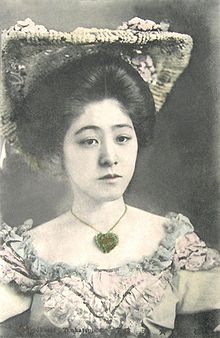Tenkatsu Shokyokusai
Tenkatsu Shokyokusai | |
|---|---|
 Tenkatsu Shokyokusai, from a picture postcard. | |
| Born | Katsu Nakai 21 May 1886 Tokyo |
| Died | 11 November 1944 |
| Other names | Madame Tenkatsu |
| Occupation(s) | Actress, magician |
Tenkatsu Shokyokusai (松旭斎 天勝, 21 May 1886 – 11 November 1944), also known as Katsu Kanazawa, was a Japanese magician and actress.
Early life
[edit]Katsu Nakai was born in Tokyo. After her father's pawn-shop business failed, she worked as an apprentice at a tempura shop belonging to then-famous magician Ten'ichi Shokyokusai (1853-1912), of whom she later became an assistant.[1] From 1901[2] to 1903, they performed on tour in the United States, where teenaged Tenkatsu was described as a "dainty Japanese beauty"[3] and as a geisha.[4] She was sometimes referred to as Tenichi Shokyokusai's wife or widow,[5] or as his stepdaughter, perhaps because of the difference in their ages.[6]
Career
[edit]Shokyokusai became a well-known magician in her own right.[5] She headed her own troupe of performers, Tenkatsu Ichiza. The company staged adaptations of Western plays, including Shakespeare's The Tempest and Oscar Wilde's Salome, with herself in the title role.[7][8] "Madame Tenkatsu" toured with her company in the United States in 1924 and 1925,[9][10][6] including shows in Hawaii[11] and at the Hippodrome in New York.[12] She is said to have introduced American jazz to Japan in 1925, when she brought a group of Chicago-based musicians home to tour with her.[13][14]
Shokyokusai appeared in several films, including Tenkatsujo no Hagoromai (Feather Cloak Dance of Miss Tenkatsu, 1906).[15] She was said to have a diamond embedded in one of her teeth.[16]
Personal life
[edit]Shokyokusai retired from the stage in 1936, and she died in 1944, aged 58 years. A biography of Shokyokusai appeared in Japanese in 1968, by Gashō Ishikawa.[17]
References
[edit]- ^ Atkins, E. Taylor (2001). Blue Nippon: Authenticating Jazz in Japan. Duke University Press. p. 289. ISBN 978-0-8223-2721-9.
- ^ "Japanese Jugglers (continued)". San Francisco Chronicle. 1901-09-08. p. 34. Retrieved 2020-10-30 – via Newspapers.com.
- ^ "Jap Jugglers who Mystify". The New York Times. 1903-02-19. p. 9. Retrieved 2020-10-30 – via Newspapers.com.
- ^ "Geisha Girl's Romantic Life". The Inter Ocean. 1902-05-25. p. 45. Retrieved 2020-10-30 – via Newspapers.com.
- ^ a b "Tenkatsu to be Honor Guest at Reception Here". The Los Angeles Times. 1924-04-28. p. 21. Retrieved 2020-10-30 – via Newspapers.com.
- ^ a b "Japanese Girls and 'Excuse Me' at Alhambra". The Ogden Standard-Examiner. 1925-02-27. p. 6. Retrieved 2020-10-30 – via Newspapers.com.
- ^ Oshima, Hisao. "The Tempest and Japanese Theatrical Traditions: Noh, Kabuki, and Bunraku" in Tobias Döring and Virginia Mason Vaughan, eds., Critical and Cultural Transformations: Shakespeare's The Tempest, 1611-Present, Yearbook of Research in English and American Literature 29 (2013): 151-152.
- ^ Cucullu, Lois (September 2011). "Wilde and Wilder Salomés: Modernizing the Nubile Princess from Sarah Bernhardt to Norma Desmond". Modernism/Modernity. 18 (3): 495–524. doi:10.1353/mod.2011.0057. S2CID 144435685.
- ^ "Famous Theatrical Troupe of Japan to be Seen in Honolulu". Honolulu Star-Bulletin. 1924-01-29. p. 11. Retrieved 2020-10-30 – via Newspapers.com.
- ^ "Capacity House Greets Japanese Troup at Haven". Times Herald. 1924-12-16. p. 15. Retrieved 2020-10-30 – via Newspapers.com.
- ^ "Big Japanese Troupe of Theater People Here". Hawaii Tribune-Herald. 1924-02-08. p. 6. Retrieved 2020-10-30 – via Newspapers.com.
- ^ "Japanese Girls Balk at Lodging and Food Here". Daily News. 1924-09-07. p. 45. Retrieved 2020-10-30 – via Newspapers.com.
- ^ Otake, Tomoko (2009-08-21). "Yokohama to stage truly magical jazz". The Japan Times. Retrieved 2020-10-29.
- ^ Mori, Masato (March 16, 2018). "Jazz and the Japanese". Historical Recordings Collection, National Diet Library, Japan. Retrieved October 29, 2020.
- ^ da Silva, Joaquin. "1906". Chronology of Japanese Cinema. Retrieved 2020-10-30.
- ^ "Japanese Artists to Open Show Saturday". Honolulu Star-Bulletin. 1924-02-01. p. 5. Retrieved 2020-10-30 – via Newspapers.com.
- ^ 石川雅章 (1968). 松旭斎天勝 (in Japanese). 東京: 桃源社. OCLC 33712896.
